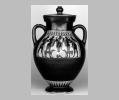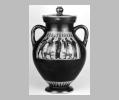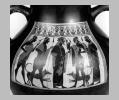| Collection: | Indiana University Art Museum |
| Summary: | Sides A and B: Dionysos and retinue greeted by men. |
| Ware: | Attic Black Figure |
| Painter: | Attributed to the Amasis Painter |
| Date: | 550 BC - 540 BC |
| Dimensions: | H. 36.3 cm (with lid); H. 31.5 cm; D. of foot 12.2 cm; max. D. 21.5 cm; D. of neck 14.2 cm; D. of lid 14.0 cm. |
| Primary Citation: | |
| Shape: | Amphora |
| Beazley Number: | 350464 |
| Period: | Archaic |
Condition:
The vase is published and photographed cleaned (von Bothmer, infra, pl. 11.1 and 2) but as it is now, it has the following minor details of cosmetic. On Side A, restored attachment of right handle, most of second lotus from left, Dionysos' cloak at right thigh from groin to knee and towards dog's nose, tip of left youth's foot and round area below it; some broad cracks on the lower vase-body have in-painting. On Side B, restored right lotus, fragments of vase-body in front of lower handle attachment, piece in upper thigh of youth who greets Dionysos, and filling of cracks and rips as on Side A. There is a small triangular patch in the lower portion of the vase-body to the right of the picture panel. The lid is repaired at one side in the plaster.
Decoration Description:
Side A and B are rather similar. On Side A, Dionysos stands in the center, facing right, a drinking horn in his left hand. The god is greeted by a man who wears a felt cap and chlamys, followed by a youth dressed in a himation. Two more youths, both in short mantles, stand behind Dionysos. His entourage carry spears and they are accompanied by two dogs which rear slightly, with front legs raised. Side B is similar but has Dionysos attended by four youths, each wearing mantles. The dogs snarl but less violently, with their feet on the ground. Added red (largely the same on both sides): backs, necks, stripes on dogs; fillets, circles around nipples and mantles on youth; on Side A, felt cap on bearded fellow, details on himation of youth behind, and Dionysos' hair in back; there are two red lines under picture panel, one as a groundline for the scene; a red band to mark the junction of the foot to the body of the vase. Added white: Dionysos' chiton. Florals: festoons of addorsed palmettes and lotuses; Side A has additional "half unit" at each end; Side B does not have this feature. The hearts of the palmette are red and the three spiked petals of the lotus flowers are also red. The short base line for the palmette is red. Aspects of the florals are important considerations for the chronology of the works of the Amasis Painter (von Bothmer, infra. p. 78).
This vase is published by Dietrich von Bothmer in an article which establishes innovatively the contours of the Amasis Painter's unusually long career; the vase is given to the earliest part of the artist's "middle period" (infra, p. 80).
Shape Description:
The top of the lip is glazed and the interior of the neck is glazed at the top in a broad band; there is a broad band of added red at the inner edge of the lip. Broad echinus foot, regular ovoid body, shoulder joining fluidly into a broad neck. Rim set off, projecting sharply outwards, the carination slightly undercut. Fine ridge on the outer edge of lip; handles steeply rising, curving sharply towards lower part of neck, round in section. The lid has an off-set outer rim, low and dome-shaped, with a pomegranate knob; below, a vertical lip to fit inside amphora neck; interior of dome evenly curved; interior pomegranate partially hollowed, hole pierced from within.
Essay:
Collection History:
Gift of Mrs. Nicolas H. Noyas. Ex collection Dr. Athos Moretti, Bellinzona, Switzerland.
Sources Used:
Other Bibliography:



